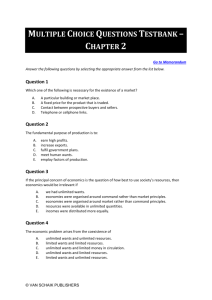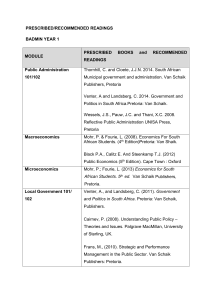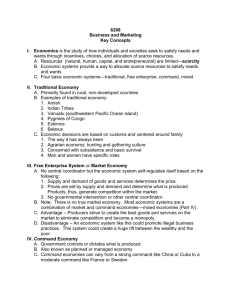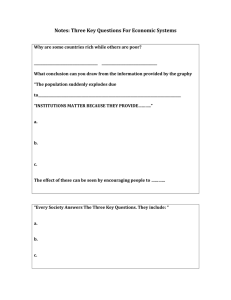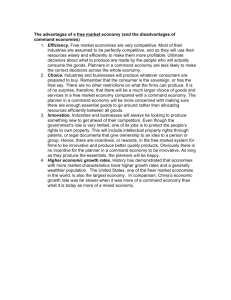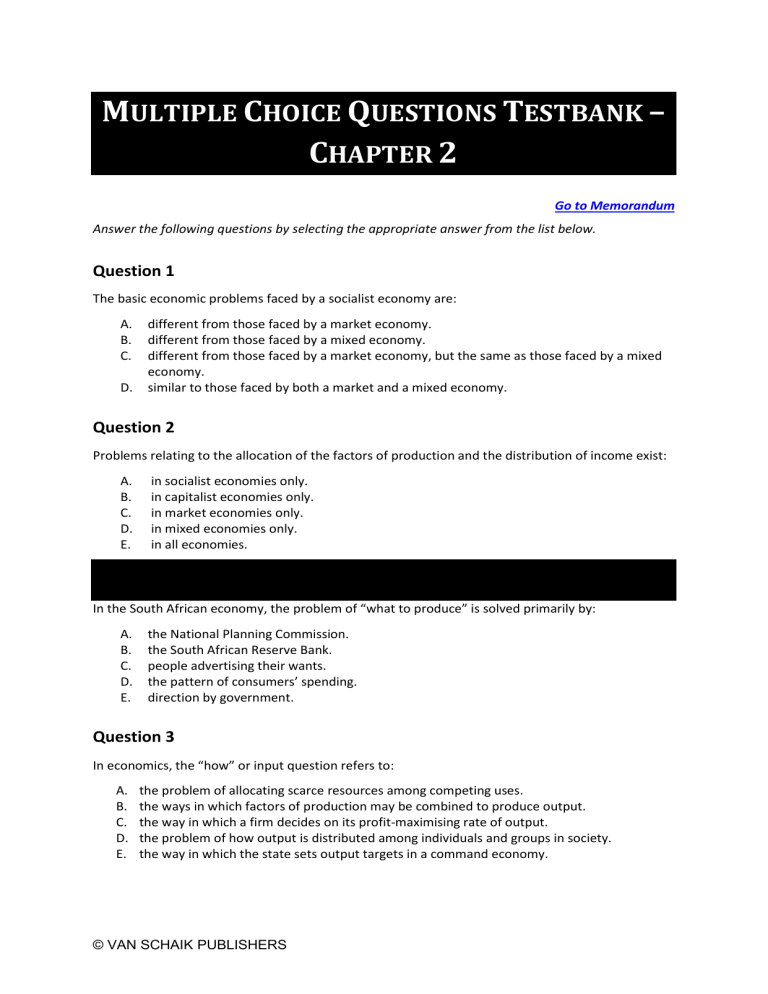
MULTIPLE CHOICE QUESTIONS TESTBANK – CHAPTER 2 Go to Memorandum Answer the following questions by selecting the appropriate answer from the list below. Question 1 The basic economic problems faced by a socialist economy are: A. B. C. D. different from those faced by a market economy. different from those faced by a mixed economy. different from those faced by a market economy, but the same as those faced by a mixed economy. similar to those faced by both a market and a mixed economy. Question 2 Problems relating to the allocation of the factors of production and the distribution of income exist: A. B. C. D. E. in socialist economies only. in capitalist economies only. in market economies only. in mixed economies only. in all economies. In the South African economy, the problem of “what to produce” is solved primarily by: A. B. C. D. E. the National Planning Commission. the South African Reserve Bank. people advertising their wants. the pattern of consumers’ spending. direction by government. Question 3 In economics, the “how” or input question refers to: A. B. C. D. E. the problem of allocating scarce resources among competing uses. the ways in which factors of production may be combined to produce output. the way in which a firm decides on its profit-maximising rate of output. the problem of how output is distributed among individuals and groups in society. the way in which the state sets output targets in a command economy. © VAN SCHAIK PUBLISHERS Question 4 In a pure market economy, the “for whom” or distribution question is largely answered: A. B. C. D. E. by existing patterns of income and wealth. by a democratic vote. by the preferences of central planners. according to the needs of individuals and groups in society. by the extent to which government decides to redistribute purchasing power. Question 5 The basic questions of “what to produce” and “for whom” to produce are essentially interdependent because: A. B. C. D. E. a particular level of output may be produced by many different combinations of inputs. different patterns of factor use generate different patterns of income distribution. income and wealth are concentrated in the hands of the economically powerful. markets cannot be relied upon to allocate resources efficiently. different patterns of distribution generate different patterns of demand and therefore different patterns of resource allocation. Question 6 In a market system, which of the following is incorrect? A. B. C. D. E. Prices allocate resources equally among competing industries and sectors in the economy. Prices indicate relative scarcities and costs of production. Relative price changes are a determinant of firms’ profits and therefore encourage or discourage production. Prices are measures of consumers’ willingness to pay for goods and services. Prices signal to consumers how much they must sacrifice to obtain a commodity. Question 7 In the context of a market system, which of the following statements is incorrect? A. B. C. D. E. The market mechanism acts to coordinate the plans of consumers and producers. Firms face incentives to produce what consumers demand. Price signals steer scarce economic resources into optimal use. A highly unequal distribution of income and wealth may exist. Goods and services are distributed in accordance with consumers’ needs. © VAN SCHAIK PUBLISHERS Adam Smith’s concept of the invisible hand suggests that: A. B. C. D. E. the selfish actions of rational individuals will generate an efficient allocation of scarce resources. the public-spirited actions of individuals will generate an efficient allocation of scarce resources. the systematic but largely invisible intervention of government in the operation of markets will generate an efficient allocation of scarce resources. market failure cannot arise, and there is therefore no economic role for the state. no overall efficient allocation of scarce resources is likely without coordinated economic planning. Question 9 In terms of Adam Smith’s concept of the invisible hand, an efficient overall allocation of resources is likely to result from: A. the regulation of markets by economic planners. B. the operation of command rather than market economies. C. the behaviour of public-spirited people, who consider the benefits that their actions will have on others. D. the behaviour of self-interested individuals striving to maximise their own wellbeing. Question 10 In a command system, economic planners would be concerned with all but one of the following areas. The exception is: A. B. C. D. E. an appropriate allocation of resources between the production of consumer goods and capital goods. the elimination of bottlenecks in the supply of key commodities. the establishment of an effective chain of command to pass production targets to producer units. implementation of incentives to achieve output targets. freedom of movement of capital to respond to profit signals throughout the economy. Question 11 Simple economies can be described in terms of three major economic flows. These are: A. B. C. D. E. income, spending and saving. spending, production and saving. income, saving and production. income, spending and production. income, spending and net exports. © VAN SCHAIK PUBLISHERS The two major market types in the simple circular flow of income and expenditure are: A. B. C. D. E. public markets and private markets. free markets and regulated markets. factor markets and foreign exchange markets. goods markets and service markets. goods markets and factor markets. Question 13 In economics, the “how” or production question refers to A. B. C. D. E. the problem of allocating scarce resources among competing users. the ways in which factors of production may be combined to produce output. the way in which a firm decides on its profit-maximising rate of output. the problem of how output is distributed among individuals and groups in society. the way in which the state sets output targets in a command economy. Question 14 In a pure market economy, the for whom or distribution question is largely answered A. B. C. D. E. by existing patterns of income and wealth. by democratic vote. by the preferences of central planners. according to the needs of individuals and groups in society. by the extent to which government decides to redistribute purchasing power. Question 15 The basic questions of what to produce and for whom to produce are essentially interdependent because A. B. C. D. a particular level of output may be produced by many different combinations of inputs. different patterns of factor use generate different patterns of income distribution. income and wealth are concentrated in the hands of the economically powerful. markets cannot be relied upon to allocate resources efficiently. © VAN SCHAIK PUBLISHERS If households have a greater desire to purchase fresh pasta, more resources will ultimately be allocated to the production of fresh pasta in a market economy because A. B. C. D. E. fresh pasta has a good nutritional content. consumer groups will inform pasta manufacturers of the change in demand. the price of fresh pasta will be driven up, thereby making fresh pasta production more profitable. economic planners will respond to the change in demand by raising the output quotas of fresh pasta producers. the prices paid for factors of production used in the fresh pasta industry will tend to fall. Question 17 In a capitalist market economy, which of the following is incorrect? A. B. C. D. E. Prices allocate resources equally among competing industries and sectors in the economy. Prices indicate relative scarcities and costs of production. Relative price changes are a determinant of firms’ profits and therefore encourage or discourage production. Prices are measures of consumers’ willingness to pay for goods and services. Prices signal to consumers how much they must sacrifice to obtain a commodity. Question 18 In the context of a pure market economy, which of the following statements is incorrect? A. B. C. D. E. The market mechanism acts to coordinate the plans of consumers and producers. Firms face incentives to produce what consumers demand. Price signals steer scarce economic resources into optimal use. A highly unequal distribution of income and wealth may exist. Goods and services are distributed in accordance with consumers’ needs. Question 19 In a command economy, resource allocation is brought about by A. B. C. D. E. price signals driven by relative price changes. the collective preferences of central planners. the behaviour of self-interested individuals striving to maximise their own well-being. the principle of consumer sovereignty. the desire of producers to maximise profits. Question 20 In a command-type economy, economic planners would be concerned with all but one of the following areas. The exception is © VAN SCHAIK PUBLISHERS A. B. C. D. E. an appropriate allocation of resources between the production of consumer goods and capital goods. the elimination of bottlenecks in the supply of key commodities. the establishment of an effective chain of command to pass production targets to producer units. implementation of incentives to achieve output targets. freedom of movement of capital to respond to profit signals throughout the economy. Question 21 Which one of the following is not a basic economic system? A. B. C. D. E. Monetary system Market system Mixed system Command system Traditional system Question 22 Which one of the following statements about economic systems is correct? A. B. C. D. E. A traditional system is a dynamic system. A command system is an efficient system. A market system is a fair/equitable system. Most economic systems are mixed systems. There are many examples of pure market economies in the world. Question 23 Which one of the following statements is correct? A. B. C. D. E. Modern economic systems are largely based on tradition. During the past few decades many countries have abandoned command as the major coordinating mechanism of their economic systems. A market can exist only if there is physical contact between prospective buyers and prospective sellers of a good or a service. Competition and negotiation is essentially the same thing. In market capitalism each participant is acutely aware of the needs of others. © VAN SCHAIK PUBLISHERS South Africa has a: A. B. C. D. E. pure market economy. pure command economy. traditional economy. mixed economy. classical economy. Question 25 Which one of the following is incorrect? Market capitalism is characterised by: A. B. C. D. E. strong government intervention. individualism. private freedom. private property. decentralised decision making. Question 26 In market capitalism, economic activity is driven by: A. B. C. D. E. altruism. concern for others. self-interest. the public interest. religious values. Question 27 Privatisation means that: A. B. C. D. E. the private sector sells assets to the government. the government obtains private assets without compensation. the government obtains private assets but compensates the owners. the government sells some of its assets to the private sector. one private firm sells assets to another private firm, thereby keeping the assets private. © VAN SCHAIK PUBLISHERS Nationalisation: A. B. C. D. E. means that government obtains assets from the private sector, with or without compensation. is a common feature of market economies. tends to occur in capitalist economies. means that the national government sells assets to private companies. tends to boost the confidence of foreign investors in an economy. Question 29 Which one of the following does not pertain to the factor markets? A. B. C. D. E. Capital Entrepreneurship Money Labour Natural resources Question 30 Which one of the following does not represent the income of a factor of production? A. B. C. D. E. Rent Money Wages Profit Interest Question 31 Complete the following statement. Households sell their ____________ in the __________ market. They then use their income to buy __________ in the __________ market. A. B. C. D. goods; goods; factors of production; factor factors of production; factor; goods; goods goods; factor; factors of production; goods factors of production; goods; goods; factor © VAN SCHAIK PUBLISHERS Which one of the following statements is correct? A. B. C. D. E. South Africa has an unlimited supply of natural resources. The N1 highway between Cape Town and Johannesburg is an example of a capital good. Wealth and income are synonyms (have the same meaning). In a market system there is an agency that instructs the various participants in the economy how to allocate their resources. South Africa has a pure market economy. © VAN SCHAIK PUBLISHERS
